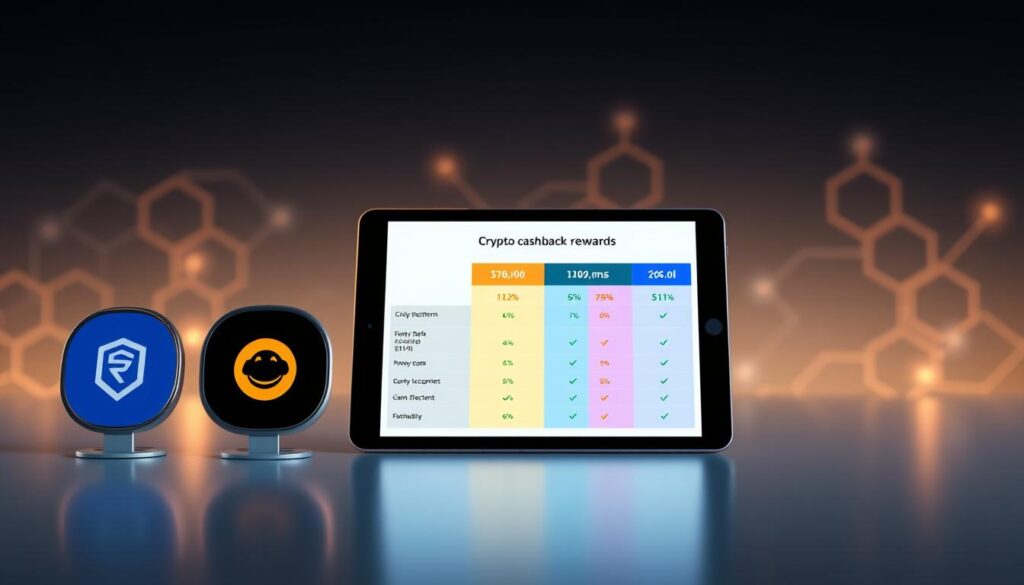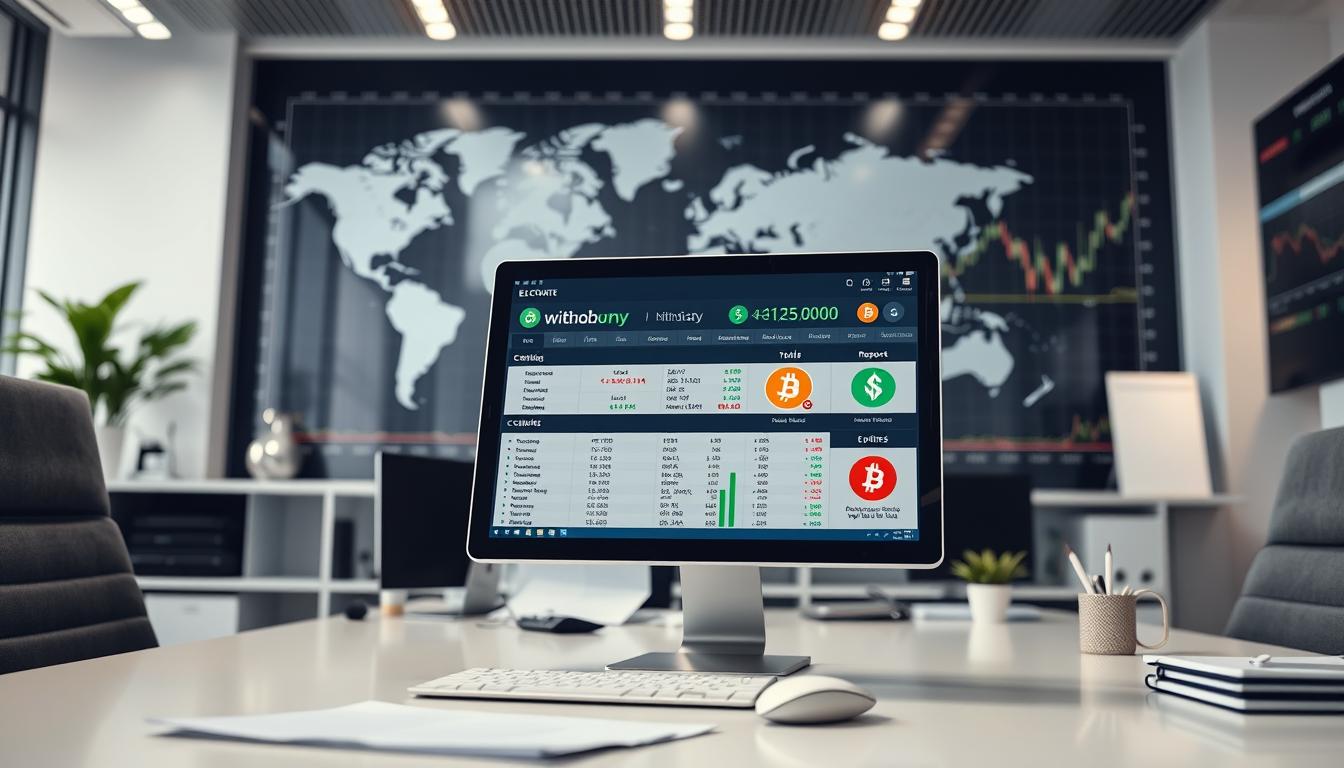Now Reading: Best Crypto Lending Platforms for U.S. Investors
- 01
Best Crypto Lending Platforms for U.S. Investors
Best Crypto Lending Platforms for U.S. Investors

Cryptocurrency lending is a growing way for U.S. investors to earn passive income. This guide looks at the top crypto lending platforms for U.S. investors. It focuses on compliance, security, and returns. American users need to carefully choose platforms that meet changing regulations and market trends.
Key Takeaways
- Compare top platforms compliant with U.S. financial regulations.
- Learn how to assess interest rates and risk profiles of leading crypto lending platforms.
- Understand tax implications tied to crypto lending activities.
- Discover security measures critical for U.S. investors.
- Explore strategies to balance returns with regulatory requirements.
Understanding Cryptocurrency Lending: A Primer for U.S. Investors
Cryptocurrency lending is a new way for investors to grow their digital assets. It’s different from traditional banking. This section will explain the basics so you can understand top cryptocurrency lending services.
How Crypto Lending Differs from Traditional Banking
Crypto lending platforms offer much higher returns than banks. They give annual yields of 5–20%. Unlike banks, there are no physical branches. Transactions happen directly on the blockchain.
Lenders use digital assets like Bitcoin or stablecoins instead of fiat currency.
The Basic Mechanics of Lending Digital Assets
Lending digital assets involves three main parts:
- Smart contracts: These are automated agreements that enforce terms without needing approval from a third party.
- Collateral: Borrowers often use crypto as collateral to reduce the risk of default.
- Interest accrual: Interest is earned continuously and can be paid in crypto or USD.
Why Cryptocurrency Lending Has Gained Popularity
Investors are drawn to crypto lending for three key reasons:
- Higher yields: Crypto lending offers much higher returns than traditional savings accounts.
- Decentralized access: Best crypto lending sites for U.S. investors allow direct participation without needing a bank account.
- Institutional legitimacy: Big names like Fidelity and Goldman Sachs are now involved in crypto lending.
The Potential Benefits of Crypto Lending as a Passive Income Stream
American investors looking for passive income often miss out on crypto lending’s benefits. The top crypto lending platforms for U.S. investors offer APYs that beat traditional savings accounts and some dividend stocks. For instance, stablecoins like USDC or Tether (USDT) can earn 5–10% APY on top of your initial investment.
Reputable crypto lending companies let users lend out idle assets while keeping ownership. This way, you can turn unused crypto into a source of income without selling it. Unlike stocks, which need to increase in value, crypto lending earns you money through fixed-term or flexible loans.
- Higher yields: Crypto lending often beats Treasury bonds or savings accounts.
- Portfolio diversification: Adds non-correlated assets to traditional holdings.
- Compound growth: Reinvesting earned interest boosts long-term gains.
- Asset flexibility: Choose from Bitcoin, Ethereum, or algorithmic stablecoins based on market views.
Choosing the right platform is key to risk-adjusted returns. Top platforms auto-compound earnings, but it’s important to check platform security, liquidity terms, and past performance. While crypto’s volatility is a risk, using reputable providers can help meet passive income goals.
When looking at options, compare APYs across platforms. Choose FDIC-insured custodians or those following SEC guidelines. Mixing high-yield options with stablecoin products can help manage risk.
Navigating Risks in the Crypto Lending Landscape
Crypto lending offers chances, but it’s important to watch out for risks. U.S. investors need to look at four key areas to protect their assets and earnings.
Platform Risk and Counterparty Concerns
Issues like FTX’s 2022 bankruptcy show the dangers of platform instability. Trusted lending platforms for digital assets focus on strong security, audits, and openness. It’s wise to check a platform’s history and read user feedback to steer clear of shaky services.
Market Volatility Factors
- Price changes can lead to automatic loan liquidations.
- Down markets raise default risks for borrowers, affecting lender earnings.
Liquidity Considerations for Lenders
Some platforms lock up funds during market troubles. Lenders must weigh the chance for high returns against the need for quick access to money. Secure crypto lending options might offer flexible withdrawal options but require a close look at liquidity terms.
Insurance and Asset Protection Options
Some platforms insure deposits or collateral, but coverage varies. Third-party insurers like Euler Hermes now offer crypto-specific policies. Always check policy details, as most plans don’t cover risks like exchange hacks or regulatory seizures.
Regulatory Framework: What U.S. Investors Must Know Before Lending
U.S. investors looking into top-rated lending platforms in the U.S. need to understand new rules. Following federal and state laws is key to protect your money and avoid legal trouble. Not following these rules can result in fines or being blocked from leading crypto lending platforms.
Current SEC Stance on Crypto Lending Products
The SEC sees some crypto lending products as securities. This is based on the Howey Test. If a platform offers fixed returns or pools investments, it might face close scrutiny. It’s important to check if a platform has SEC exemptions or licenses.
State-by-State Variations in Lending Regulations
- Wyoming: It’s a great place for crypto lending platforms because of its friendly crypto banking laws.
- New York: It has strict rules, needing a BitLicense for any in-state operations.
- Texas: It doesn’t have specific crypto lending laws, but platforms must follow federal AML rules.
KYC and AML Requirements for U.S. Users
To join a platform, you’ll need to show your ID and address. Some platforms also watch your transactions to fight money laundering. Not following these rules can lock your account or limit withdrawals.
Best Crypto Lending Platforms for U.S. Investors in 2023
Choosing the right crypto lending platform is key. It’s about finding the right mix of returns, security, and following the law. For U.S. investors, the best crypto lending platforms need to keep up with new rules and offer good returns. This section looks at three types of top services to help you find what fits your goals.
Centralized Platform Options
Centralized platforms are big in the U.S. market. But, recent events show we need to be careful. Here are a few examples:
- Nexo: Offers quick loans but needs strict ID checks.
- BlockFi: Known for BIA accounts, but keep up with legal news.
- Celsius: Be cautious due to its 2022 bankruptcy, showing risks in central models.
DeFi Lending Protocols Available to Americans
DeFi platforms let you keep control of your assets. Here are some key ones:
- Aave: Supports stablecoins and risky tokens through smart contracts.
- Compound: Its interest rates change based on supply and demand.
- MakerDAO: Focuses on lending DAI with certain collateral needs.
Platforms with FDIC-Insured Partners
Some services offer FDIC protection for fiat deposits. For instance:
- BlockFi’s BIA protects USD deposits up to $250k through partner banks.
- Crypto.com’s Savings Accounts have FDIC insurance for USD.
Remember, FDIC protection only covers fiat, not crypto assets.
Security Features That Define Top-Tier Lending Platforms
U.S. investors need to pick secure crypto lending options. Look for platforms with strong security measures. These companies use advanced protocols to keep user funds and data safe.
These protections are key as cyber threats grow. Before you decide, check how platforms keep your digital assets safe. They use technical and procedural layers for this.

- Multi-signature wallets requiring multiple approvals for transactions.
- Cold storage for storing the majority of assets offline, reducing hacking risks.
- Regular third-party security audits to validate infrastructure resilience.
- Bug bounty programs encouraging ethical hackers to identify vulnerabilities.
- Insurance funds or custodial safeguards to mitigate loss exposure.
Look at a platform’s transparency reports and certifications. Check if they have SOC 2 or ISO 27001. Also, see how they handle security issues.
Platforms that are open about their security and respond quickly to issues are trustworthy. They also use extra security like two-factor authentication and IP restrictions.
Choosing secure crypto lending options from trusted companies reduces fraud risk. Make sure these platforms follow U.S. rules and keep their security up to date. This way, your assets are safe and you can still access them easily.
Comparing Interest Rates: Which Platforms Offer the Best Returns?
When picking the best crypto lending sites for U.S. investors, it’s key to look at interest rates. Rates change based on the asset, rate types, and special offers. This makes it crucial to compare to get the most from your investment.
Fixed vs. Variable Rate Options
Fixed rates mean you get a set return over a set time, great for those who like less risk. Sites like BlockFi and Nexo offer 6-8% fixed yields for BTC. On the other hand, variable rates change with market demand; Celsius might offer up to 9% annually for ETH.
Fixed rates keep your earnings steady but lock your money. Variable rates can change but offer flexibility. It’s a trade-off between stability and potential for more.
Token-Specific Interest Rate Variations
Interest rates vary by token. Stablecoins like USDC earn 3-5%, while less common tokens like SOL can reach 12% due to high demand. Rates are influenced by:
- Market liquidity needs
- Crypto utility (e.g., governance tokens)
- Risk tolerance of lenders
Top platforms clearly show rates for each token. Aave and Compound, for example, show big differences between BTC (5-7%) and ADA (10-14%).
Promotional Rates and Loyalty Programs
Promotions can boost your earnings in the short term. Kraken offers 10% introductory rates for 90-day deposits. Crypto.com rewards loyalty with bonus APY. Referral programs from Gemini can increase earnings by 2-3%.
But, always check the fine print of promotions to avoid penalties for early withdrawal.
Account Requirements and Limitations for American Users
U.S. investors need to understand the rules when using trusted lending platforms for digital assets. These rules help follow the law and keep user assets safe. Key areas include deposit limits, how to verify accounts, and how to withdraw funds.
Minimum Deposit Thresholds
Each leading crypto lending platform has its own starting point. For example:
- BlockFi requires $100 minimum for crypto deposits
- Celsius allows $100 entry for select tokens
- Nexo has no minimum for crypto deposits
Platforms for small investors might not have a minimum. But, platforms offering high returns might ask for $10,000+ deposits.
Verification Procedures
U.S. users must go through KYC checks by:
- Uploading government-issued IDs
- Verifying Social Security Numbers
- Providing address proof (utility bills, bank statements)
Completing these steps can increase how much you can withdraw. It might take 1-3 business days for more detailed checks.
Withdrawal Restrictions
There are important limits to keep in mind:
- 24–72 hour processing windows
- $10,000 monthly limits on unverified accounts
- New York residents excluded from certain platforms
Rules vary by state. Texas has fewer restrictions than NY, which has strict rules under BitLicense.
How Leading Platforms Handle Asset Custody and Security
When looking for secure crypto lending options, how they handle your assets is key. Top platforms use two main ways: self-custody in DeFi and centralized custodial services. You need to decide between having control or convenience.

- Self-custody DeFi protocols let users keep their private keys. But, they must take full responsibility for keeping their assets safe.
- Centralized platforms work with trusted custodians like BitGo, Fireblocks, and Gemini Custody. They store assets offline to lower hacking risks.
Good crypto lending companies often pair custody with insurance. Some offer insurance up to $250 million. Others use their own funds to cover losses. U.S. users should check if the coverage includes theft, exchange failures, or market crashes.
Being open is important. Top platforms share proof-of-reserves reports and third-party audit results. For example, Celsius and Nexo check their reserves with firms like Deloitte. Always look at a platform’s custody whitepapers and insurance terms before putting in your money.
Tax Implications of Crypto Lending for U.S. Taxpayers
U.S. investors on best crypto lending platforms need to know tax rules to avoid fines. The IRS sees crypto lending income as taxable, needing accurate reports.
IRS Treatment of Lending Income
Interest from crypto lending is taxable income. If platforms pay in cryptocurrency, gains might lead to capital gains tax. Losses from defaults can reduce taxable income. IRS guidelines say to track every transaction, including withdrawals and reinvestments.
Record-Keeping Best Practices
- Log all transactions: deposits, withdrawals, and interest payouts
- Save platform statements and contract details
- Use tools like crypto tax software to automate records
Working with Crypto-Savvy Tax Professionals
Look for accountants who know top cryptocurrency lending services. Ask about their crypto tax form experience (Form 8949, Schedule D). Make sure they understand IRS crypto guidance, like notice 2014-21.
Strategies to Maximize Your Crypto Lending Returns
Diversifying across best crypto lending sites for U.S. investors lowers risk. Spreading funds across multiple trusted lending platforms for digital assets keeps you safe. It also helps you get the best rates.
Smartly allocate your assets. Stablecoins like USDC or USDT give steady returns with little risk. But, volatile assets like ETH or SOL might offer more but need constant watching.
Pair risky tokens with short-term loans. This limits your risk during price changes.
- Track promotional periods. Many platforms offer better rates during special times.
- Enroll in loyalty programs. These can give you better rates for being a long-term lender.
- Balance fixed and variable rates. Fixed rates protect you from market drops. Variable rates adjust to interest rate changes.
Keep an eye on platform reviews and performance. Look for hidden gems. But, don’t just follow high yields without checking the platform’s fees and security.
Regularly check your portfolio. This makes sure it matches your risk level and the market.
Common Pitfalls U.S. Investors Should Avoid When Lending Crypto
Investing in crypto lending needs careful planning to avoid big mistakes. Many investors jump into deals without checking important details. This can risk their money and follow the law. An 
Platform Selection Mistakes
Choosing the wrong platforms is a big risk. Look out for these red flags:
- Platforms that ignore U.S. laws or don’t share their licenses
- Interest rates that seem too good to be true, which they probably are
- Not enough information about who runs the platform, audits, or security
Make sure the platform is registered and listed with reputable crypto lending companies. They should be open about everything.
Overlooking Terms and Conditions
Terms often have hidden parts that affect your money. Important things to check:
- How interest is calculated (simple or compound)
- Penalties for taking your money out early
- If the platform can change rates or terms without asking you
Good platforms in the U.S. clearly explain these terms. Ignoring them can lead to bad deals.
Yield Chasing and Its Dangers
Going for high returns without thinking can be deadly. Platforms offering 20%+ annual rates might use risky methods. Choose platforms with a solid history over quick profits.
It’s important to balance how much you want to earn with how much risk you’re willing to take. Doing your homework on the platform’s history, terms, and legal standing can help avoid big problems.
The Future of Crypto Lending: Emerging Trends and Innovations
Leading crypto lending platforms are using new technologies to change how digital assets earn returns. Cross-chain lending lets users borrow or lend across different blockchains. This makes it easier to access top cryptocurrency lending services. Layer 2 solutions also aim to lower transaction costs, making it more affordable for investors.
Institutional players like banks and hedge funds are getting into crypto. This could make the market more stable but might also give more control over interest rates to a few. Decentralized insurance models are coming up to protect users without needing traditional insurers. Central Bank Digital Currencies (CBDCs) could also change things, but there are still regulatory challenges.
- Automated yield optimization tools adjust portfolios in real time
- Privacy-focused protocols like zero-knowledge proofs enhance security
- Tokenized real-world assets may expand collateral options
Regulators like the SEC are keeping a close eye on these new ideas. They want platforms to innovate but also follow the rules. U.S. investors need to watch these changes closely and focus on proven safety measures. The next few years will show if these new ideas bring lasting value or introduce new risks for crypto lenders.
Step-by-Step Guide to Setting Up Your First Crypto Lending Account
Starting with crypto lending needs careful planning. Follow this guide to set it up safely and efficiently.
Platform Selection Process
First, research best crypto lending platforms for U.S. investors. Look for platforms that follow U.S. laws and offer secure crypto lending options. Make sure they support popular cryptocurrencies. Also, check reviews to find platforms with good user interfaces and support.
Account Security Best Practices
- Enable two-factor authentication (2FA) using authenticator apps or hardware security keys.
- Create unique, complex passwords for each platform.
- Regularly review platform security audits and insurance coverage details.
Funding Options for U.S. Residents
Choose deposit methods based on speed and fees:
- ACH Transfers: Low cost but take 3-5 business days.
- Crypto Deposits: Instant but requires prior crypto holdings.
- Wire Transfers: Fast but may incur fees up to $50.
Monitoring Your Lending Portfolio
Use platform dashboards to track your investments. Set alerts for price drops or updates. Rebalance your assets every quarter to get the best returns while managing risks.
Making Informed Decisions: Building a Sustainable Crypto Lending Strategy
Creating a solid crypto lending plan starts with knowing your financial goals. First, figure out how much risk you can handle. Start with stablecoins or well-known digital assets. Then, slowly add more to your portfolio.
Spread your investments across different trusted platforms and companies. This way, you’re not relying on just one. Services like BlockFi or Nexo offer safe options for US dollar deposits. They mix new ideas with old, tried methods.
Keep an eye on how platforms perform and change over time. Watch the interest rates but don’t risk your money for high returns. In good times, lock your money for longer to earn more. In tough times, choose platforms that let you get your money fast.
Always think about taxes when you earn interest. Use IRS rules to guide you. When picking lenders, check if they follow state laws. Use resources like the SEC’s investor alerts to help.
Pair crypto lending with staking to earn more. Check out Cryptomaximal’s staking guides for tips. Update your strategy every year. Remove bad choices and add new ones that fit your goals.
Building a good strategy takes time. Look for platforms that are open and transparent. Check their audit reports and how well they support their customers. Growing wisely means planning ahead, not just acting on impulse. By adding crypto lending to your mix, you can grow your investments while managing risks.
FAQ
What are the best crypto lending platforms for U.S. investors?
Top choices for U.S. investors include Nexo, BlockFi, and Celsius. For DeFi, Aave and Compound are good options.
How does crypto lending differ from traditional banking?
Crypto lending uses smart contracts and offers higher rates. It also allows for crypto as collateral. This is different from traditional banks.
Are crypto lending platforms secure?
Yes, they use strong security like multi-signature wallets. But, always check a platform’s security before lending.
What are some reputable crypto lending companies in the U.S.?
BlockFi, Nexo, and Celsius are well-known and follow U.S. rules. They are safe choices for lending digital assets.
What risks should U.S. investors consider when lending crypto?
Risks include the platform’s stability and market volatility. Also, think about liquidity and security breaches.
How do I find the top cryptocurrency lending services?
Look for reviews and check if they follow rules. Websites that compare platforms can help you see their features and rates.
What are the typical interest rates offered by crypto lending platforms?
Rates vary from 4% to 12% or more. They depend on the asset and market. Always compare rates and understand the terms.
Do I need to verify my identity to use crypto lending platforms in the U.S.?
Yes, U.S. rules require KYC and AML checks. You’ll need to provide personal info and documents.
Can I lend my crypto assets without locking them up?
Some platforms let you lend without locking up your assets. But, you might get lower yields than with fixed terms.
How can I maximize my returns on crypto lending?
Diversify your assets and watch for special rates. Choose between fixed and variable rates wisely. Stay updated on market trends.













